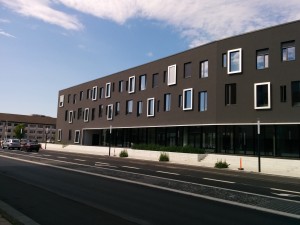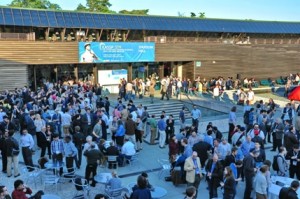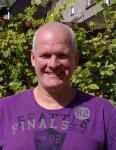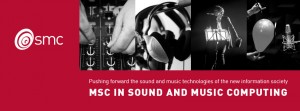The last position as Ph.D. student on our InnovationsFonden project with GN ReSound is now open for applications! The position is within hearing aid signal processing. The Ph.D. student will be employed by GN ReSound and be enrolled in the doctoral school program within Electrical and Electronic Engineering and will work with us at the Audio Analysis Lab with Prof. Mads Græsbøll Christensen as supervisor. Read more at http://www.gn.com/careers/job?jobid=2283.
Author Archives: mgc
Bob Sturm joining QMUL
Audio Analysis Lab member Bob Sturm is moving to Queen Mary University of London (QMUL) at the end of the year. QMUL is home to the Centre for Digital Music (C4DM), which is well-known in the music and audio technology research community. We wish Bob all the best and thank him for his many contributions to Aalborg University and hope to continue our collaborations with him (which actually predate him joining AAU) in the future. Good luck, Bob!
New multichannel audio database introduced at IWAENC
At IWAENC 2014, a new freely available multichannel audio database that has been recorded by members of the Audio Analysis Lab in collaboration with Signal and Information Processing at Dept. of Electronic systems will be presented. We believe that such a database has been long overdue!
The database is called Signal- and Multichannel Audio Recordings Database (SMARD). The database contains recordings from a box-shaped listening room for various loudspeaker and array types. The recordings were made for 48 different configurations of three different loudspeakers and four different microphone arrays. In each configuration, 20 different audio segments were played and recorded ranging from simple artificial sounds to polyphonic music. SMARD can be used for testing algorithms developed for numerous application, and we give examples of source localisation results.
You can read more and download the database at http://www.smard.es.aau.dk/.
Presentations at EUSIPCO 2014
The Audio Analysis Lab is well represented at this years’ EUSIPCO in Lisbon, Portugal next week. We have the following papers scheduled for presentation:
- A Broadband Beamformer Using Controllable Constraints and Minimum Variance
- Near-field Localization of Audio: A Maximum Likelihood Approach
- DOA and Pitch Estimation of Audio Sources Using IAA-based Filtering
- Spatio-Temporal Audio Enhancement Based on IAA Noise Covariance Matrix Estimates
- Robust Pitch Estimation Using an Optimal Filter on Frequency Estimates
- Robust DOA Estimation of Harmonic Signals Using Constrained Filters on Phase Estimates
- Cluster-Based Adaptation Using Density Forest for HMM Phone Recognition
PhD Stipends in Hearing Aid Signal Processing
The Audio Analysis Lab currently has two open positions as Ph.D. students on our new project on hearing aid signal processing with GN ReSound. Candidates are most welcome to read more and submit an application at http://www.stillinger.aau.dk/vis-stilling/?vacancy=681744.
Audio Analysis Lab has moved
 Over the past few weeks, the Audio Analysis Lab and its members have moved to our new location in Rendsburggade 14 along with our colleagues at AD:MT. We are now located in a brand new building at the harbor front in Aalborg, right between Musikkens Hus and the Utzon Center. In our new building, we have a nice, big corner office on the 2nd floor for the junior members of the lab, offices for senior staff, and nice new lab facilities on the ground floor, including a new listening/measurement room and the relocated Audio Visual Arena (AVA) lab featuring, among other things, an ambisonics system and a 3D tracking system.
Over the past few weeks, the Audio Analysis Lab and its members have moved to our new location in Rendsburggade 14 along with our colleagues at AD:MT. We are now located in a brand new building at the harbor front in Aalborg, right between Musikkens Hus and the Utzon Center. In our new building, we have a nice, big corner office on the 2nd floor for the junior members of the lab, offices for senior staff, and nice new lab facilities on the ground floor, including a new listening/measurement room and the relocated Audio Visual Arena (AVA) lab featuring, among other things, an ambisonics system and a 3D tracking system.
ICASSP 2014
 The Audio Analysis Lab was well-represented at this year’s ICASSP, which was held in lovely Florence, Italy. The following papers by members of the Audio Analysis Lab were presented there:
The Audio Analysis Lab was well-represented at this year’s ICASSP, which was held in lovely Florence, Italy. The following papers by members of the Audio Analysis Lab were presented there:
- Fundamental Frequency and Model Order Estimation Using Spatial Filtering
- Joint Sparsity and Frequency Estimation for Spectral Compressive Sensing
- Model Detection and Comparison for Independent Sinusoids
- Noise Reduction in the Time Domain using Joint Diagonalization
Villum Foundation Project Workshop 2014
 On May 23, the second workshop on the project Spatio-Temporal Filtering Methods for Enhancement and Separation of Speech Signals was held. Assoc. Prof. Richard Heusdens, Delft Tecnical University, gave an invited talk on distributed signal processing. Other that that, the program consisted of the following presentations:
On May 23, the second workshop on the project Spatio-Temporal Filtering Methods for Enhancement and Separation of Speech Signals was held. Assoc. Prof. Richard Heusdens, Delft Tecnical University, gave an invited talk on distributed signal processing. Other that that, the program consisted of the following presentations:
- J. R. Jensen, Near-field Localization of Audio: A Maximum
Likelihood Approach - M. Abou-Zleikha A Tree-based Ensemble Learning for Speech
Processing - S. M. Nørholm, Spatio-Temporal Audio Enhancement based on IAA
Noise Covariance Matrix Estimates - B. Sturm, A Closer Look at Deep Learning Neural Networks with Lowlevel Spectral Periodicity Features
- V. Tavakoli, A Theoretical Study of the Speech Enhancement Problem
with Distributed Microphone Arrays - S. Karimian-Azari, Robust Pitch Estimation Using an Optimal Filter on
Frequency Estimates - J. R. Jensen, SMARD – A Single and Multi-Channel Audio Recordings Database
- J. K. Nielsen, Joint Sparsity and Frequency Estimation for Spectral Compressive Sensing
- J. K. Nielsen, Bayesian vs. Classical Statistics Through Three Examples
- H. Purwins, Audio Time Series Analysis: Experiments, Computational
Analysis, & Cognitive Models - S. Karimian-Azari, Robust DOA Estimation of Harmonic Signals Using
Constrained Filters on Phase Estimates - A. Jakobsson, High resolution sparse estimation of exponentially
decaying signals - T. Kronvall, Joint DOA and Pitch Estimation using Block Sparse Techniques
- M. W. Hansen, Pitch-Based Acoustic Source Localization with
Distributed Microphone Arrays - M. G. Christensen, Multi-Channel Maximum Likelihood Pitch Estimation
The participants this year were employees working on the Villum foundation projet as well as invited guests and colleagues at AAU: Richard Heusdens, Ted Kronvall, Andreas Jakobsson, Jesper Rindom Jensen, Jesper Kjær Nielsen, Mads Græsbøll Christensen, Vincent Tavakoli, Sam Karimian-Azari, Sidsel Marie Nørholm, Martin Weiss Hansen, Hendrik Purwins, Bob Sturm, Mohamed Abou-Zleikha.
Talk on Distributed Signal Processing by Richard Heusdens
As part of the annual workshop on the Villum project, Richard Heusdens will give a one-hour introduction to distributed signal processing at 9:20 on April 23.
Title: Distributed signal processing
Abstract: In this talk we will focus on distributed signal processing algorithms. We will discuss methods based on inference in graphical models, like the mini-sum and related algorithms, and methods based on convex optimization, like the alternating direction of multipliers method (ADMM) . With respect to inference-based algorithm, we will focus on the (generalized) linear-coordinate descent algorithm, an iterative optimization algorithm with a convergence rate comparable to that of the min-sum algorithm, but with significantly less parameters to transmit per iteration. With respect to convex optimization based algorithms, we will focus on ADMM, a simple but powerful algorithm that is well suited for distributed convex optimization, and variations of it, like the recently introduced BiADMM algorithm, which can be used for both synchronous and asynchronous updating schemes.
 Bio: Richard Heusdens is an Assoc. Prof. at the Dept. of Mediamatics, Delft University of Technology. He received his HTS (institute of technology) diploma from the HTS Alkmaar in 1988. He received the M.Sc. and Ph.D. degrees from Delft University of Technology, Delft, The Netherlands, in 1992 and 1997, respectively. Since 2002, he has been an Associate Professor in the Department of Mediamatics, Delft University of Technology. In the spring of 1992, he joined the digital signal processing group at the Philips Research Laboratories, Eindhoven, The Netherlands. He has worked on various topics in the field of signal processing, such as image/video compression and VLSI architectures for image processing algorithms. In 1997, he joined the Circuits and Systems Group of Delft University of Technology, where he was a Postdoctoral Researcher. In 2000, he moved to the Information and Communication Theory (ICT) Group, where he became an Assistant Professor responsible for the audio and speech processing activities within the ICT group. He is involved in research projects that cover subjects such as audio and speech coding, speech enhancement, and digital watermarking of audio. Research projects he is involved in cover subjects such as audio and speech coding (Sicas, ARDOR, ASC), speech enhancement (SpEnt), and digital watermarking of audio (DIWAMETRICS)
Bio: Richard Heusdens is an Assoc. Prof. at the Dept. of Mediamatics, Delft University of Technology. He received his HTS (institute of technology) diploma from the HTS Alkmaar in 1988. He received the M.Sc. and Ph.D. degrees from Delft University of Technology, Delft, The Netherlands, in 1992 and 1997, respectively. Since 2002, he has been an Associate Professor in the Department of Mediamatics, Delft University of Technology. In the spring of 1992, he joined the digital signal processing group at the Philips Research Laboratories, Eindhoven, The Netherlands. He has worked on various topics in the field of signal processing, such as image/video compression and VLSI architectures for image processing algorithms. In 1997, he joined the Circuits and Systems Group of Delft University of Technology, where he was a Postdoctoral Researcher. In 2000, he moved to the Information and Communication Theory (ICT) Group, where he became an Assistant Professor responsible for the audio and speech processing activities within the ICT group. He is involved in research projects that cover subjects such as audio and speech coding, speech enhancement, and digital watermarking of audio. Research projects he is involved in cover subjects such as audio and speech coding (Sicas, ARDOR, ASC), speech enhancement (SpEnt), and digital watermarking of audio (DIWAMETRICS)
New M.Sc. program in Sound and Music Computing at AAU
 In September 2014, AAU will start a new M.Sc. program in Sound and Music Computing. The program features a unique combination of traditional engineering disciplines like signal processing and machine learning with newer ones like interaction design and prototyping and fabrication techniques and strong knowledge about various aspects of sound and music, including perception and cognition, acoustics, psycho-acoustics. The new program will run both in Aalborg and in Copenhagen and is open for both national and international applicants from a wide range of B.Sc. programs. The Audio Analysis Lab has been heavily involved in the creation of the program with our colleagues in Copenhagen and will also be involved in teaching courses and supervising students in the program. You can read more at http://www.studieguide.aau.dk/uddannelser/kandidat/93920/.
In September 2014, AAU will start a new M.Sc. program in Sound and Music Computing. The program features a unique combination of traditional engineering disciplines like signal processing and machine learning with newer ones like interaction design and prototyping and fabrication techniques and strong knowledge about various aspects of sound and music, including perception and cognition, acoustics, psycho-acoustics. The new program will run both in Aalborg and in Copenhagen and is open for both national and international applicants from a wide range of B.Sc. programs. The Audio Analysis Lab has been heavily involved in the creation of the program with our colleagues in Copenhagen and will also be involved in teaching courses and supervising students in the program. You can read more at http://www.studieguide.aau.dk/uddannelser/kandidat/93920/.